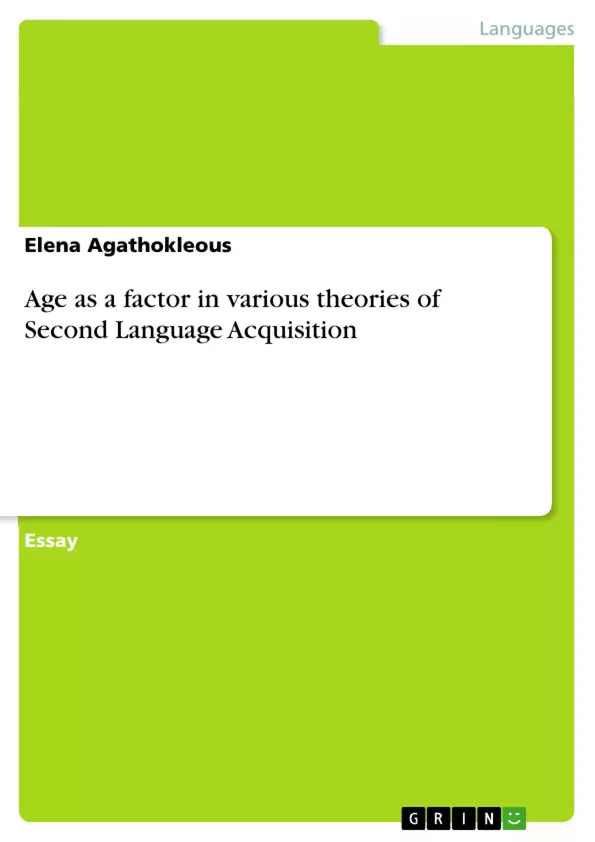A discussion of how age as a factor influences second language acquisition. On one hand, theories like Chomsky’s theory on Universal Grammar (UG) and the monitor theory support that language faculty in children is innate and consists of the possession of a language acquisition device for the processing of language which facilitates language acquisition for a critical period and it is not available to older learners thus favoring younger learners in second language acquisition. On the other hand theories like cognitive psychology and socio-cultural theories favor older learners which are more able to practice and pay attention in a process of intentional learning in which no special brain devices or structures are considered necessary.
Inhaltsverzeichnis (Table of Contents)
- Age as a Factor in Second Language Acquisition
- Theories of Second Language Acquisition
- Universal Grammar
- Monitor Theory
- Cognitive Psychology and Socio-Cultural Theories
- Interactionist Perspectives
- Socio-Cultural Perspectives
- Research on Second Language Acquisition
- The Critical Period Hypothesis
- Age as a Factor in Formal Learning Settings
- The Barcelona Age Factor (BAF) Project
- The Importance of Length of Exposure and Input
Zielsetzung und Themenschwerpunkte (Objectives and Key Themes)
This paper investigates the role of age as a factor in Second Language Acquisition (SLA). The author analyzes various theories of SLA, focusing on how they account for age differences in language acquisition, particularly in relation to the Critical Period Hypothesis. The paper also examines the implications of these theories for both naturalistic and instructional settings.
- Theories of Second Language Acquisition and their implications for age differences
- The Critical Period Hypothesis (CPH) and its relevance to naturalistic language learning
- The impact of age on SLA in both natural and instructional settings
- The role of exposure and input quality in SLA
- The importance of considering factors beyond age in SLA
Zusammenfassung der Kapitel (Chapter Summaries)
The paper begins by discussing the concept of SLA and the role of age in influencing the acquisition process. It then presents various theories of SLA, exploring their perspectives on age differences in language acquisition, including Universal Grammar, the Monitor Theory, cognitive and socio-cultural theories, and interactionist and socio-cultural perspectives. The paper then delves into the Critical Period Hypothesis (CPH) and its implications for both natural and formal learning environments.
The author examines research findings related to the CPH, particularly in naturalistic contexts, where the acquisition of a second language by immigrants has been observed. The paper then transitions to analyzing the age factor in formal learning settings, focusing on the role of age in instructional contexts and the effectiveness of early language instruction. This section includes insights from the Barcelona Age Factor (BAF) project, which investigated the impact of age on SLA in school settings.
Finally, the paper discusses the importance of considering factors beyond age in SLA, such as length of exposure and input quality. It highlights the differences in exposure and input between natural and instructional settings and the implications of these differences for SLA. The author argues that while age can be a good predictor of ultimate proficiency in natural settings, it may not be as reliable in formal learning environments. The paper concludes by emphasizing the need for further research to fully understand the complex interplay of age, learning environment, and other factors in SLA.
Schlüsselwörter (Keywords)
This paper focuses on the key concepts of Second Language Acquisition (SLA), age as a factor in SLA, the Critical Period Hypothesis (CPH), naturalistic language learning, formal learning settings, the Barcelona Age Factor (BAF) project, length of exposure, input quality, and the interplay of various factors influencing SLA.
- Quote paper
- Elena Agathokleous (Author), 2019, Age as a factor in various theories of Second Language Acquisition, Munich, GRIN Verlag, https://www.grin.com/document/1066636



